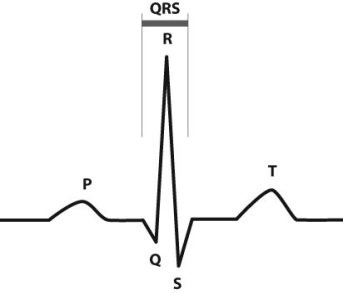Electrocardiographs (ECGs or EKGs) provide data about the electrical activity of the heart. By placing a series of "leads" on a person's chest, the electrical activity of the heart can be recorded and analyzed in order to detect irregular heartbeats (arrhythmias) and other conditions. The figure below shows a normal EKG tracing for one cardiac cycle.
 The P region represents electrical activity spreading through the atria. The QRS region represents electrical activity spreading through the ventricles. The T region represents electrical activity in the ventricles returning to rest.
The P region represents electrical activity spreading through the atria. The QRS region represents electrical activity spreading through the ventricles. The T region represents electrical activity in the ventricles returning to rest.
-Suppose a person has a heart rate of 60 beats/min and that the start of the P region until the end of the T region represents one cardiac cycle. If the x axis in the EKG is time, approximately how much time passes between the start of the P region and the end of the T region?
Definitions:
Agility
The ability to move quickly and easily, often used to describe physical coordination in sports.
Body Composition
The proportion of fat and non-fat mass in the body, often used as a health and fitness indicator.
Reaction Time
The interval between the presentation of a stimulus and the initiation of the muscular response to that stimulus.
Cognition
The mental action or process of acquiring knowledge and understanding through thought, experience, and the senses, encompassing functions such as memory, attention, and problem-solving.
Q14: Which list has structures that are involved
Q16: Why would researchers working with assisted reproductive
Q26: Anaphylactic shock is an example of an<br>A)
Q30: At what point of the diagram is
Q50: While playing soccer in your backyard, you
Q56: Which of the following cell types is
Q57: TRH is a type of _ hormone
Q57: The graphs shown indicate the range of
Q63: Which is a function of epinephrine?<br>A) release
Q74: What occurs during gastrulation?<br>A) A solid embryo